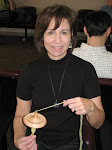Erica writes about the arts for a local paper called The Planet Weekly. Here's the link. http://www.theplanetweekly.com/ . She asked if she could write a piece on my spinning. So I said yes. Today I got a list of 5 questions to respond to. I didn't get much time because it was due shortly after I received them...but here's what I wrote....(It really messes with my perfectionism not to have more time to edit the text)....
1. I use the term "fiber arts" to describe using animal or plant-based fibers as a form of creative self-expression or design. The fiber arts include working with the fibers to make supplies, such as yarn, as well as to create unique pieces of wearable art. Animal fibers include fine wools (merino, romney, targhee), llama, alpaca, angora rabbit, mohair, cashmere, silk, and many others. Plant-based fibers that are very popular include bamboo, cotton, and linen. My love of fiber arts innocently began about 14 years ago when I was in graduate school for clinical psychology. I needed something to do for stress relief so I took a knitting class. Around the same time, my mother was dying from breast cancer. She also adored knitting. Together we would spend days together almost in quiet meditation just knitting, talking, listening to the click of our needles, and appreciating the time that we had together. Only recently have I learned how to spin and dye my own yarns. And when that happened, this little hobby of knitting a few scarves each year blossomed into a passion. Taking the raw fiber freshly shorn from an animal, scouring it, dyeing it into a gorgeous spectrum of colors, spinning it into yarn that can then be used to make a garment for someone to wear is incredibly satisfying. It is also something that women have done for generations. When I am working with fibers, I feel as if I am at peace. Interestingly, my maternal grandfather was a tailor who sewed for the fashion houses in New York, and my paternal grandfather was a miliner who was in the business of making the grand hats of the 1930s and 1940s. However, I could never even sew a button back on a shirt or hem a pair of slacks. It always amazed me that I grew up in this wonderful fiber family but never felt a part of it until now. So I guess I really have come home.
2. What do I do? I'm a spinster. I spin fiber into yarn. I use a fantastic wooden spinning wheel called the Schacht Matchless. First I buy the fiber in ecru or undyed. Sometimes I will spin it first, but usually, I will dye the fiber before I spin it. I started dyeing with Kool-Aid and food safe dyes and have recently moved to using professional grade dyes. The Kool-Aid dyes are fun but the professional dyes give a much wider array of colors and provide the consistency that I require. After the fiber dries, I can spin it into yarn. Then I have a lot of decision to make: How do I want to spin the yarn? What will the yarn be used for? How much yarn is needed for a specific project? Every answer will contribute to the overall appearance of the finished product. And each decision matters. Spinning is certainly relaxing and repetitive but it is certainly not a mindless activity. It requires planning and consistency, the ability to respond to the inherent characteristics of the fiber, knowing when to let go of control, and a whole lot of just plain old playing around!!
3. Social consciousness is important to me. I could not enjoy this work if I felt in anyway that animals were being harmed. I have been a vegetarian since 1978, and am committed to using fibers from healthy and well cared for animals. It helps to buy from local farms, such as Cozy Cove Llamas outside of Huntsville. But there are other ways, too. For example, when I work with silk, I only work with tussah silk. Tussah silk or peace silk is harvested from the cocoons of silk worms that have been allowed to live out their natural life expectacy. In addition, I am boycotting fibers from Australia, as are many of the well-known clothing designers, due to the inhumane treatment of merino sheep. Here's the webpage http://www.savethesheep.com/ . We can make a difference. I use my fiber arts blog for Tikkun Olam. Tikkun Olam is Hebrew meaning "Repair the world." According to this tradition, inhabitants of the earth are expected to fix it, to make it better than we found it.
4. In the October, I am thrilled to say that I will be showing and demonstrating fiber arts, such as spinning, preparing fibers, knitting, at Kentuck with the West Alabama Fiber Guild. Also in October, I am joining with some other fiber artists in town, Heidi Atwood and Sara Whitver, and a shepherdess in north Alabama, Cozette O'Neil. We have formed a group called Why Knot Fiber Collective and we will be exhibiting and selling our fiber arts at the Southeastern Animal Fiber Fair outside of Asheville, NC. No doubt, we are very excited about tht opportunity. Next, in early November as the holiday season begins, I will be teaching some workshops at One Night Only Artique. These workshops will be in dyeing silk scarves as well as dyeing yarn so that everyone can offer a special, handmade, one of a kind work of art to everyone on their special gift list. We will have fun, get our hands wet, and make some beautiful wearable art!!!
5. I think it is interesting to know that men invented knitting. They began tying a variety of knots as sailors. They made nets and other fabrics all through knot tying. Then, they began knitting fabrics with the lanolin still in the wool in order to stay dry. Finally, during the Industrial Age, when men moved inside to operate machinery, woman began to do the knitting. Also, interesting is the way that the fiber arts have really taken off since the development of social networking sites such as Ravelry.com and online shops, such as Etsy.com.
Wish me luck! I'll post the finished article as soon as it comes out.
Monday, September 8, 2008
Subscribe to:
Post Comments (Atom)





1 comment:
a good read beth!
Post a Comment